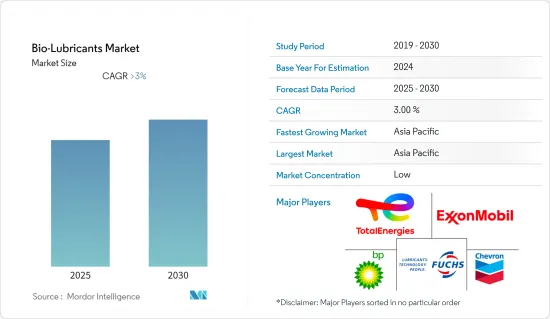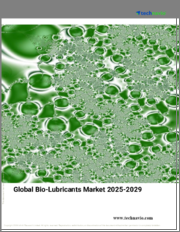
|
시장보고서
상품코드
1640615
바이오 윤활유 : 시장 점유율 분석, 산업 동향 및 통계, 성장 예측(2025-2030년)Bio-Lubricants - Market Share Analysis, Industry Trends & Statistics, Growth Forecasts (2025 - 2030) |
||||||
■ 보고서에 따라 최신 정보로 업데이트하여 보내드립니다. 배송일정은 문의해 주시기 바랍니다.
바이오 윤활유 시장은 예측기간 동안 3% 이상의 CAGR을 나타낼 전망입니다.

주요 하이라이트
- COVID-19는 2020년 시장에 부정적인 영향을 미쳤습니다. 그러나 시장은 2022년 팬데믹 전 수준에 이르렀으며 앞으로도 안정된 성장이 예상됩니다.
- 바이오 윤활유는 일반적으로 석유 기반 윤활제로 인한 피부 염증을 일으키지 않습니다. 또한 에너지 사용량과 인건비 절감, 직원 안전 개선, 환경 조건 개선, 기계 수명 연장, 생산량 증가 등 다양한 장점이 있어 시장 성장을 가속하고 있습니다.
- 바이오 윤활유는 지방산을 에스테르화하거나 식물성 오일을 트랜스에스테르화함으로써 제조됩니다. 이 공정은 균일한 산/염기 촉매 8-10의 존재하에 또는 이온 교환 수지를 사용하여 장쇄 알코올로 유지됩니다. 이 공정은 바이오 윤활유의 비용을 증가시킵니다. 이것은 시장의 성장을 방해할 가능성이 높습니다.
- 바이오 윤활유의 물리화학적 특성을 개선하기 위해 다양한 R&D 프로젝트가 완료되었습니다. 이러한 연구는 바이오 윤활유가 석유 기반 오일의 대체품으로 사용될 수 있음을 밝혀내고 시장에 기회가 될 것으로 예측됩니다.
- 아시아태평양은 세계 시장을 독점하고 있으며, 중국, 인도, 일본 등의 국가에 의한 소비가 가장 많습니다.
바이오 윤활유 시장 동향
자동차 및 운송 부문의 바이오 윤활유 수요 증가
- 바이오 윤활유 시장에서는 자동차·운송 부문이 큰 점유율을 차지하고 있습니다. 운송 업계는 성능, 수명, 에너지 효율, 환경 배려 등 윤활유의 특성을 높이는 것을 중시하고 있습니다. 바이오 그리스는 건설 차량, 임업 기계, 레일 플랜지, 레일 곡선, 항해 기계 등 다양한 용도로 효과를 발휘합니다.
- 많은 산업에서 바이오의 금속 절삭유 및 쿨런트가 연삭, 치아 절단, 일반 기계 가공에 사용되어 시장 성장의 원동력이 될 것으로 예상됩니다. 저독성, 고점도 지수, 강력한 윤활 특성, 기계의 장수명화, 고연소 온도 등의 특징으로부터, 바이오의 윤활유는 모두 자동차 산업에서 기존의 윤활유를 대체할 것으로 예상됩니다.
- 중국의 자동차 부문 확대는 바이오 윤활유 수요를 개척할 것으로 예상됩니다. 국제자동차공업회(OICA)에 따르면 중국은 가장 큰 자동차 생산국입니다. 이 나라에서만 2021년에 2,608만 2,220대의 자동차를 생산했습니다.
- 또한 인도에서는 승용차와 상용차 판매량이 크게 증가했습니다. 예를 들어 2021-2022년 승용차의 국내 판매 대수는 306만 9,499대로 2020-21년에 비해 13% 증가했습니다. 앞서 언급한 모든 요인들은 예측 기간 동안 세계 시장을 견인할 것으로 예상됩니다.
아시아태평양이 시장을 독점
- 중국은 아시아태평양에서 3위인 바이오 윤활유 소비국입니다. 이 지역의 발전산업 확대는 예측기간 동안 바이오 윤활유 시장을 견인할 것으로 예상됩니다.
- 2021년 인도의 재생가능 에너지 용량은 147.1기가와트를 초과했습니다. 이는 2020년 134.5 기가와트를 넘어 시장기간의 봉우리였으며 시장 성장을 크게 뒷받침하고 있습니다.
- 2021년 중국에서는 약 8,377테라와트 시간의 전력이 생산되었습니다. 이것은 전년 대비 거의 10% 증가한 것입니다. 수력발전을 제외하면 2021년에는 모든 에너지원이 더 많이 소비되었으며 풍력발전과 태양광발전이 주로 증가했습니다.
- 또한 일본 정부는 고품질 흑탄을 사용하는 고에너지·저배출 기술에 의해 국내에 45기의 석탄화력발전소를 신설할 계획도 세우고 있습니다. 국내 발전소 수가 증가함에 따라 발전소에서 사용되는 바이오 윤활유 수요 가속이 예측 기간 동안 예상됩니다.
- 따라서 이러한 전력산업 증가는 아시아태평양의 바이오 윤활유 시장을 견인할 것으로 예상됩니다.
바이오 윤활유 산업 개요
바이오 윤활유 시장은 세분화되어 있습니다. 시장의 주요 기업으로는 BP plc, Chevron Corporation, Exxon Mobil Corporation, TotalEnergies, FUCHS 등이 있습니다.
기타 혜택 :
- 엑셀 형식 시장 예측(ME) 시트
- 3개월간의 애널리스트 서포트
목차
제1장 서론
- 조사의 성과
- 조사의 전제
- 조사 범위
제2장 조사 방법
제3장 주요 요약
제4장 시장 역학
- 성장 촉진요인
- 바이오베이스 윤활유 수요를 촉진하는 규제 규범
- 기타 촉진요인
- 성장 억제요인
- 바이오 베이스 윤활유의 높은 가격
- 기타 억제요인
- 산업 밸류체인 분석
- Porter's Five Forces 분석
- 공급기업의 협상력
- 소비자의 협상력
- 신규 진입업자의 위협
- 대체품의 위협
- 경쟁도
제5장 시장 세분화(금액 베이스 시장 규모)
- 제품 유형별
- 엔진 오일
- 변속기·유압 작동유
- 금속가공유
- 일반 공업용 오일
- 기어 오일
- 그리스
- 프로세스 오일
- 기타 제품 유형
- 최종 사용자 산업별
- 발전
- 자동차 및 기타 운송
- 중장비
- 음식
- 야금 및 금속가공
- 화학제조
- 기타 최종 사용자 산업
- 지역별
- 아시아태평양
- 중국
- 인도
- 일본
- 한국
- 기타 아시아태평양
- 북미
- 미국
- 캐나다
- 멕시코
- 기타 북미
- 유럽
- 독일
- 영국
- 이탈리아
- 프랑스
- 러시아
- 기타 유럽
- 남미
- 브라질
- 아르헨티나
- 기타 남미
- 중동 및 아프리카
- 사우디아라비아
- 남아프리카
- 아랍에미리트(UAE)
- 기타 중동 및 아프리카
- 아시아태평양
제6장 경쟁 구도
- 인수합병, 합작사업, 제휴, 협정
- 시장 점유율(%)**/랭킹 분석
- 주요 기업의 전략
- 기업 프로파일
- Axel Christiernsson
- Carl Bechem Lubricants India Private Limited
- BP plc
- Cargill
- Chevron Corporation
- Cortec Corporation
- Environmental Lubricants Manufacturing, Inc.
- Exxon Mobil Corporation
- FUCHS
- KCM Petro Chemicals
- Novvi, LLC.
- PANOLIN AG
- Shell plc
- TotalEnergies
제7장 시장 기회와 앞으로의 동향
- 보다 우수한 특성을 가지는 신제품의 도입
The Bio-Lubricants Market is expected to register a CAGR of greater than 3% during the forecast period.

Key Highlights
- COVID-19 negatively impacted the market in 2020. However, the market reached pre-pandemic levels in 2022 and is expected to grow steadily in the future.
- Bio-based lubricants do not cause skin inflammation, which is generally caused by petroleum-based lubricants. Additionally, they have various advantages, such as reduced energy usage, labor costs, increased employee safety, improved environmental conditions, increased machine life, and increased production, thereby augmenting the market's growth.
- Bio-lubricants are produced by esterifying a fatty acid or trans-esterifying vegetable oil. This process is being held with long-chain alcohol in the presence of a homogeneous acid/base catalyst 8 -10 or using an ion-exchange resin. This process increases the cost of bio-based lubricants. This is likely to hinder the market's growth.
- Various R&D projects have been completed to improve the physicochemical properties of bio-based lubricants. These studies have found that bio-lubricants can be used as substitutes for petroleum-based oils and are projected to act as an opportunity for the market.
- The Asia-Pacific region dominated the global market, with the largest consumption from countries such as China, India, and Japan.
Bio-Lubricants Market Trends
Increase in Demand for Bio-Lubricants in Automotive and Transportation Sector
- The automotive and transportation sector accounts for a considerable share of the market for bio-lubricants. The transportation industry emphasizes enhancing lubricant properties such as performance, longevity, energy efficiency, and environmental friendliness. Bio-greases work well in various applications, including construction vehicles, forestry machinery, rail flanges, rail curves, and nautical machinery.
- Many industries use bio-based metal cutting fluids and coolants for grinding, gear cutting, and general machining, which are anticipated to drive market growth. Due to their low toxicity, high viscosity index, potent lubricating properties, longer machine service life, high combustion temperature, and other characteristics, bio-based lubricants are expected to displace conventional lubricants in the automotive industry eventually.
- The expansion of the automotive sector in China is anticipated to cultivate the demand for bio-lubricants. According to the International Organization of Motor Vehicle Manufacturers (French: Organisation Internationale des Constructeurs d'Automobiles) (OICA), China is the largest producer of automobiles. The country alone produced 2,60,82,220 units of vehicles in 2021.
- Also, India witnessed a significant increase in the sales of passenger vehicles and commercial vehicles. For instance, the domestic sales of passenger vehicles were 3,069,499 for 2021-2022, representing an increase of 13% compared to 2020-21. All the aforementioned factors are expected to drive the global market during the forecast period.
Asia-Pacific to Dominate the Market
- China is the third largest bio-lubricant consumer in the Asia-Pacific region. The expanding power generation industry in the region is anticipated to drive the bio-lubricant market during the forecast period.
- In 2021, India had a capacity for more than 147.1 gigawatts of renewable energy. This was higher than the peak for the period under consideration in 2020, which was 134.5 gigawatts, supporting the market's growth significantly.
- Around 8,377 terawatt hours of electricity were produced in China in 2021. This was an increase over the previous year of almost 10%. Except for hydropower, all energy sources were more significantly consumed in 2021, with wind and solar power generating increases being majorly used.
- Moreover, the Japanese government has also been planning to build 45 new coal-fired power plants in the country by using high-energy, low-emission technology, which uses high-quality black coal. With the increasing number of power plants in the country, accelerated demand for bio-lubricants for use in power plants is expected during the forecast period.
- Therefore, this increase in the power industry is expected to drive the bio-lubricants market in the Asia-Pacific region.
Bio-Lubricants Industry Overview
The bio-lubricants market is fragmented in nature. Some of the major players in the market include BP p.l.c., Chevron Corporation., Exxon Mobil Corporation, TotalEnergies, and FUCHS, among others
Additional Benefits:
- The market estimate (ME) sheet in Excel format
- 3 months of analyst support
TABLE OF CONTENTS
1 INTRODUCTION
- 1.1 Study Deliverables
- 1.2 Study Assumptions
- 1.3 Scope of the Study
2 RESEARCH METHODOLOGY
3 EXECUTIVE SUMMARY
4 MARKET DYNAMICS
- 4.1 Drivers
- 4.1.1 Regulatory Norms Driving the Demand for Bio-based Lubricants
- 4.1.2 Other Drivers
- 4.2 Restraints
- 4.2.1 High Price of Bio-based Lubricants
- 4.2.2 Other Restraints
- 4.3 Industry Value-Chain Analysis
- 4.4 Porter's Five Forces Analysis
- 4.4.1 Bargaining Power of Suppliers
- 4.4.2 Bargaining Power of Consumers
- 4.4.3 Threat of New Entrants
- 4.4.4 Threat of Substitute Products and Services
- 4.4.5 Degree of Competition
5 MARKET SEGMENTATION (Market Size in Value)
- 5.1 Product Type
- 5.1.1 Engine Oil
- 5.1.2 Transmission and Hydraulic Fluid
- 5.1.3 Metalworking Fluid
- 5.1.4 General Industrial Oil
- 5.1.5 Gear Oil
- 5.1.6 Grease
- 5.1.7 Process Oil
- 5.1.8 Other Product Types
- 5.2 End-user Industry
- 5.2.1 Power Generation
- 5.2.2 Automotive and Other Transportation
- 5.2.3 Heavy Equipment
- 5.2.4 Food & Beverage
- 5.2.5 Metallurgy & Metalworking
- 5.2.6 Chemical Manufacturing
- 5.2.7 Other End-user Industries
- 5.3 Geography
- 5.3.1 Asia-Pacific
- 5.3.1.1 China
- 5.3.1.2 India
- 5.3.1.3 Japan
- 5.3.1.4 South Korea
- 5.3.1.5 Rest of Asia-Pacific
- 5.3.2 North America
- 5.3.2.1 United States
- 5.3.2.2 Canada
- 5.3.2.3 Mexico
- 5.3.2.4 Rest of North America
- 5.3.3 Europe
- 5.3.3.1 Germany
- 5.3.3.2 United Kingdom
- 5.3.3.3 Italy
- 5.3.3.4 France
- 5.3.3.5 Russia
- 5.3.3.6 Rest of Europe
- 5.3.4 South America
- 5.3.4.1 Brazil
- 5.3.4.2 Argentina
- 5.3.4.3 Rest of South America
- 5.3.5 Middle East & Africa
- 5.3.5.1 Saudi Arabia
- 5.3.5.2 South Africa
- 5.3.5.3 United Arab Emirates
- 5.3.5.4 Rest of Middle East & Africa
- 5.3.1 Asia-Pacific
6 COMPETITIVE LANDSCAPE
- 6.1 Mergers & Acquisitions, Joint Ventures, Collaborations, and Agreements
- 6.2 Market Share(%)**/Ranking Analysis
- 6.3 Strategies Adopted by Leading Players
- 6.4 Company Profiles
- 6.4.1 Axel Christiernsson
- 6.4.2 Carl Bechem Lubricants India Private Limited
- 6.4.3 BP p.l.c.
- 6.4.4 Cargill
- 6.4.5 Chevron Corporation
- 6.4.6 Cortec Corporation
- 6.4.7 Environmental Lubricants Manufacturing, Inc.
- 6.4.8 Exxon Mobil Corporation
- 6.4.9 FUCHS
- 6.4.10 KCM Petro Chemicals
- 6.4.11 Novvi, LLC.
- 6.4.12 PANOLIN AG
- 6.4.13 Shell plc
- 6.4.14 TotalEnergies
7 MARKET OPPORTUNITIES AND FUTURE TRENDS
- 7.1 Introduction of New Products with Better Properties
샘플 요청 목록


















